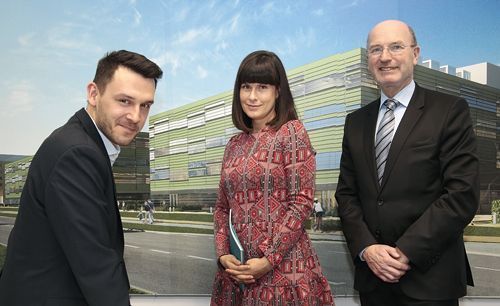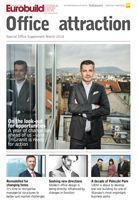A Decade of Poleczki Park
Trends
Rafał Ostrowski, ‘Eurobuild CEE’: UBM has a large portfolio of assets in Austria, Germany and Poland. How does Poleczki Park compare to these others?
Rudolf Grossmayer, member of the management board of Poleczki Park, UBM: We have many different office developments, but they are not business parks. For many years Poleczki Park was the biggest single project in our portfolio and therefore it was very much our focus.
Poleczki now has six buildings comprising 84,000 sqm of office space in total. What’s your plan for this park right now?
Rudolf Grossmayer: We have completed a certain stage in the park. There is only one building still to be built in the so called ‘core zone’. Our target is to complete this core zone within two years and then what is to be built in the outer zone can be developed separately. We have obtained a new development permit for the outer zone, so we are now allowed to build higher buildings. Our strategy is to build them on demand, because we have queries from time to time from big tenants who want BTS buildings.
It’s almost ten years since you started the construction of Poleczki Park. What has been the stay-rate among the first tenants who leased space back then in the complex?
Jakub Mirosławski, sales director, UBM: The first phase of Poleczki Park was fully leased in 2009 and 2010. These were mainly five- and seven-year leases and 90 pct of them have now been renewed. This high retention rate is the result, on the one hand, of the fact that companies don’t want to change their addresses too often; and on the other, I think, it confirms that they simply like it here. This is a good place, especially since the road network has been improved in Mokotów district in recent years. So they see can’t see the point of moving out.
What have you done do to achieve such a high stay-rate?
Jakub Mirosławski: I think that maintaining a good transport infrastructure is the key thing. This includes a shuttle bus service, facilities for cyclists such as changing-rooms, bicycle racks and so on, as well as adding parking spaces for cars. The park is not just the buildings, but all the infrastructure that goes with them – and we keep on modernising this space. I think this has been appreciated.
You’ve built a multi-storey car park for 576 vehicles. Why not an underground car park instead?
Jakub Mirosławski: This is just about the costs. It allows us to offer parking spaces for a lower rent of app. EUR 50–60 per month (?). As a result, the tenants are more willing to rent them and the important thing is that we have an excellent parking ratio of around one spot per 30 sqm of office space. In the city centre, for example, it’s more like one parking spot per 100 sqm. Other business parks with underground car parks probably have something around one space per 50 sqm. So our parking ratio is very good and we can offer virtually any number of spaces desired to our tenants.
And who mostly benefits from this?
Jakub Mirosławski: Most of our tenants have many cars. These are often companies, which do a lot of business trips. But what is very important is that we provide excellent benefits to the employers, who can give more parking spaces to their employees. In the city centre it is only the management who can have parking spaces, but in our park the director’s assistant can also come to work by car. So the companies can attract employees from outside Warsaw, because you can comfortably reach the park by car from Grodzisk Mazowiecki, Pruszków, Sochaczew or even Skierniewice. This gives the employers great flexibility and is a massive advantage in the employee market.
Poleczki organises a number of events for the tenants, including a food truck day and yoga classes on the grass outside the office. Is all this effort paying off?
Katarzyna Szumańska-Kalisz, PR and marketing manager, UBM Polska: Yes, it does. This is what the market expects. If we have the space to organise such events, and if we hear from people that they want them, then we can simply do it.
Jakub Mirosławski: I think that we follow the market trends in many respects but to some extent we are pioneers. We are able to offer events that are a bit different to those you get in high rise buildings in the centre.
Katarzyna Szumańska-Kalisz: Of course, we are not the only ones who have yoga classes and food truck days. At some skyscrapers in the centre it’s also possible to host such events, but our biggest asset is the large space outside that can be made available to our tenants. And we also allow our tenants use it for their own events and even for their family events. The only condition we is that the space is left in the same condition.
What do you want to achieve by organising events?
Katarzyna Szumańska-Kalisz: We want to engage our tenants, as we did, for example, with our yoga classes. One of our clients is Orientana, a company that sells organic Ayurvedic cosmetics. So this product is targeted more or less to the same customer as our yoga classes. The company took part in the organisation of that event, they were able to showcase their products, and they also offered free dermatological examinations. We have many pharmaceutical companies in our park, so we would also be happy to engage them in health events. Our other plans include a badminton tournament, since we have a nice area in the park where badminton can easily be played.
What else are you doing to keep hold of your tenants?
Katarzyna Szumańska-Kalisz: We have to think about everything. Starting with the signage system – because we don’t want the guests of our tenants to get lost here, and so we have improved the signage – down a comprehensive rebranding, which we completed last year. That included changing our logo and the name of the park, from which we removed the word ‘business’ – and involved changing all our communication tools, like the web page, brochures, etc. We also opened new Facebook and Instagram accounts. We renovated two pylons on ul. Poleczki, giving them new logos and lighting. Every building now has its name visible on the façade. We wanted to do this because, after ten years, we felt that the park needed refreshing.
I’ve heard from one developer, which is active in the rapidly developing Wola district, that now people don’t want to work in business parks and instead want to work close to city centre. Would you agree?
Rudolf Grossmayer: I wouldn’t, but of course only time will tell. For sure, some companies want to be in the city centre, because they feel it’s a matter of keeping up their reputation to be located there – but this is not being driven by the tenants themselves. So I think there is a market for both: those who want a nice working place at a reasonable price and others who want the reputation of having a city centre location. Of course, the rents here are much lower than in Wola. That’s a big difference. A law office needs to be there, but many international businesses sometimes have back offices that need to be close to the airport. So our location is much more preferable for them than in the city centre. And also we absorb typical Mokotów tenants, because this district has some traffic problems and tenants want to avoid that but don’t want to go to the city centre because of the costs there. And our advantage is that we have very attractive rents and low service charges, which is also important for tenants.
And what is the price difference?
Jakub Mirosławski: Poleczki Park has rents of around EUR 13–14 per sqm, which is close or a just bit higher than in Mokotów district, but in the city centre rents are above EUR 17–19. Nevertheless, Poleczki is very attractive in this regard and also because of the lower service charges.
You are planning to build one more building in Poleczki and then sell the entire complex of seven office buildings and the multi-level car park. What kind of yield could be expected for the sale of such project?
Rudolf Grossmayer: The yield could be 7.5 pct or 8 pct, depending on what you are basing your figures on. You can take this as being the fully leased income, when the buildings are fully occupied – but buildings never actually are and usually our park is between 90 pct and 100 pct leased, while other parks are even below that. The price per square metre, of course, is lower here than in the city centre, but the return on your investment is higher. Of course, it is a prime asset in our portfolio and our strategy is to sell the finished projects in order to obtain additional funds for the development of new projects. This is going to happen sooner or later, but we have not decided on any timeframe for this.





















































